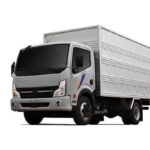The truck chassis, often referred to as the frame, is the most critical component determining a truck’s durability and operational capability. It acts as the backbone, supporting the entire weight and connecting all other parts into a unified whole. This article provides detailed information on the structure, roles, and common types of truck chassis.
The Role of a Truck Chassis
The truck chassis plays a pivotal role, directly impacting the lifespan and performance of the vehicle. Specifically:
- Support: The chassis serves as the primary load-bearing platform, supporting the entire weight of the cabin, cargo box, engine, drivetrain, and cargo.
- Connection: The chassis links all vehicle components into a unified structure, ensuring stability and synchronized operation.
- Load Bearing: The chassis withstands significant loads from cargo and forces exerted during operation. The chassis’s durability dictates the vehicle’s carrying capacity and safety.
- Safety: A robust chassis contributes to stable vehicle operation, minimizing vibrations and enhancing impact resistance, thus protecting the driver and cargo.
Truck Chassis Structure
Truck chassis are constructed from high-strength steel, undergoing heat treatment to enhance rigidity and durability. The exterior is coated with an electrostatic powder coating to prevent rust and protect the frame from environmental factors. The chassis structure typically includes:
- Main Beams (Longitudinal Members): These are the primary load-bearing components, running lengthwise along the vehicle.
- Cross Members: These connect the main beams, forming a sturdy skeletal frame.
- Mounting Brackets: Used to attach other components such as the engine, gearbox, and axles.
Types of Truck Chassis
Currently, two common types of truck chassis are prevalent:
1. Body-on-Frame (Separate) Chassis
Body-on-frame chassis feature a separate body and frame structure, connected by bolts and rubber mounts.
- Advantages: Easy to repair and replace components; good sound insulation; excellent torsional rigidity.
- Disadvantages: Heavier weight, leading to higher fuel consumption; rear-end damage susceptibility in collisions.
 Body-on-frame chassis diagram
Body-on-frame chassis diagram
2. Unibody (Monocoque) Chassis
Unibody chassis integrate the frame, floor, and body into a single, unified structure.
- Advantages: Lighter weight, improving fuel efficiency; lower center of gravity, enhancing stability; improved safety in collisions.
- Disadvantages: More difficult to repair and replace; lower load-bearing capacity compared to body-on-frame chassis.
 Unibody chassis diagram
Unibody chassis diagram
Principles for Protecting the Truck Chassis
To extend lifespan and ensure operational safety, adhere to the following chassis protection principles:
- Regular Maintenance: Periodically inspect and tighten bolts, clean, and repaint the chassis when necessary.
- Avoid Overloading: Transport cargo within the permitted weight limits, preventing excessive stress on the chassis.
- Drive Safely: Minimize collisions and traffic accidents.
- Regular Cleaning: Remove mud, dirt, and chemicals from the chassis to prevent rust.
Conclusion
This truck chassis structure guide highlights its crucial role, influencing various aspects of the vehicle. Understanding the structure, function, and types of chassis helps users choose the right truck for their transportation needs and perform proper maintenance, ensuring safety and economic efficiency.

